When Mexico City’s Sistema de Transporte Colectivo (STC) closed certain metro cars in February 2011 in order to prevent gay men from using them for sex, the public conversation about the ban highlighted how the metro is more than just a transportation artery … The appropriation of certain metro cars as meeting and hookup sites for gay men exemplifies the clash between the STC and its users, and the closure of these cars illuminates the complex relationship between the political class that controls the city and the LGBTQ community.
Cruising public transit
Source: Briarpatch Magazine
Every day in Mexico City, over four million people – about 20 per cent of the metropolitan area’s population – pack into the underground metro system. Serving the largest urban population in the western hemisphere, the Sistema de Transporte Colectivo (STC) shuttles 335 trains between 195 stations. Footsteps from the billions of passengers who have taken the metro since it opened in 1969 have worn grooves in the stone-tiled stairs of the most popular stations.
When the STC closed certain metro cars in February 2011 in order to prevent gay men from using them for sex, the public conversation about the ban highlighted how the metro is more than just a transportation artery; it is a key part of Mexico City’s huge informal economy. Vendors hawking everything from pirated ranchera CDs to bobby pins enter trains at every station despite official posters warning passengers against buying anything.
It is also an important cultural and political space that hosts spontaneous musical performances and official exhibitions of pre-Columbian artifacts. When fares were increased from three to five pesos per trip at the end of 2013, commuters jumped or ducked the turnstiles en masse while police stood by helplessly. The movement was hashtagged #PosMeSalto, which translates to “I’ll just jump.”
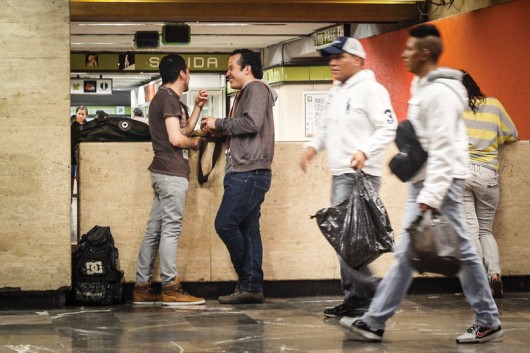
The appropriation of certain metro cars as meeting and hookup sites for gay men exemplifies the clash between the STC and its users, and the closure of these cars illuminates the complex relationship between the political class that controls the city and the LGBTQ community.
When Mexico City legalized same-sex marriage in late 2009, Alejandro Rojas, the city’s secretary for tourism, said that Mexico City “will be a very exciting and daring place for a honeymoon, and [gay tourists] will take advantage of the fact that Mexico will welcome them with the due respect and tolerance that their preferences deserve.” By the summer of 2010, the city had inaugurated an office to promote gay tourism, the first of its kind in Latin America.
While Mexico City officials sold their city as a “daring” and “avant-garde” destination to foreign tourists, Mexican LGBTQ people, particularly those who lived outside of the federal district, continued to face intense repression. In the first eight months of 2009, 40 “homosexual persons” were reportedly murdered in the state of Michoacán, an area infamous for insecurity thanks to violence related to narcotics traffic. Violence against transgender sex workers occurs throughout the country.
In May 2007 in the border city of Ciudad Juarez, 40 transsexual and transgender sex workers were detained, viciously assaulted, and robbed by 20 members of the military police. Compounding the problem of homophobia in the general public, police throughout Mexico often fail to label homophobic assaults as such, meaning that statistics misrepresent the scale of violence faced by LGBTQ people. Around the time Mexico City legalized same-sex marriage, a report in the city’s newspaper, El Universal, showed that 30 per cent of LGBTQ people claimed to experience discrimination by the police and 20 per cent claimed to have been assaulted by the police.
Metrear
Known as metrear or cajita feliz (which also refers to a McDonald’s happy meal), the practice of men meeting men for socialization and sex on the metro overlaps with a rich and shifting geography of public sex in the city.
Enrique Gomez, a freelance journalist and host of the LGBTQ-themed radio show Diversidad Ciudana, was 17 and dating a girl when he was introduced to metrear in 1990.
“I was traveling home from UNAM’s library [Universidad Nacional Autónoma de México]. My girlfriend got into the first train, but I missed it. I noticed that the car I got in was predominantly men, and I linked eyes with one. He came over, touched me, and then we began to talk. I felt a sexual attraction so I invited him to a porn cinema in front of Parque Alameda Central where we fucked in the bathroom.”
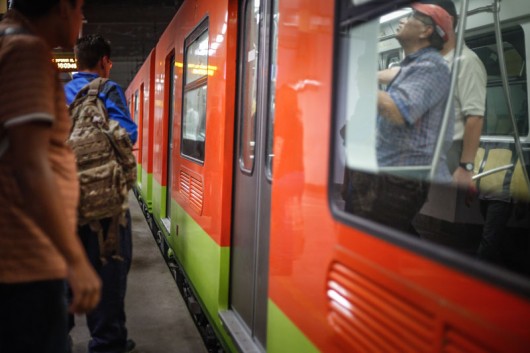
Gomez is very precise in his description of which particular subway cars are spaces for metrear. “[In the early 1990s], the last train was gay in the night. They used it for sex – blowing, sometimes even fucking – but in the day when it was full, every metro line had its own car. For example, on Line 1, it was the fourth car near the second door from the back. It was always very specific. Today it is the last car all the time. The cars of the past are less popular and the men are older.”
One of the most popular line stops is at Ciudad Universitaria, the site of UNAM and home to over 200,000 students. The last car on the train heading away from the university is a popular hookup spot for students in the late afternoon. For example, Diego (a pseudonym) was introduced to metrear as a 28-year-old graduate student at UNAM. “We left the metro, walked to a park, and fucked like animals. He knew all the paths and the ways around the fences and everything.”
Although Diego and Gomez stumbled into the world of metrear, other men come to know about it through one of many websites and online groups dedicated to arranging and discussing meetings. The grainy photos and videos of men found on online porn-sharing sites are another way in which technology spreads knowledge that used to be spread by word of mouth.
The metro line serving the upscale business and shopping district Polanco is popular with commuters. “Between 6:30 and 9:30 a.m., it is so crowded that you can fuck,” observes Gomez.
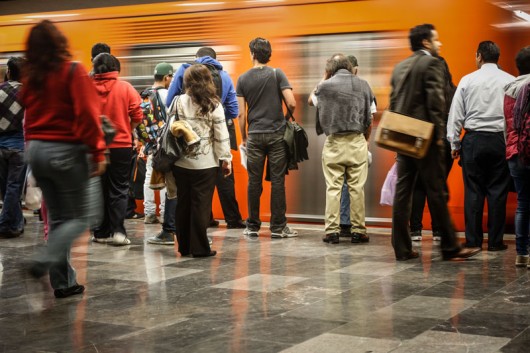
According to Gomez, most of the participants in metrear are men – gay-identified or not – who come from the lower and middle classes, and the way they participate is frequently conditioned by the geography and time of their daily commute. A 2008 article in the newspaper Milenio paints a picture of metro security and authority deliberately ignoring the phenomenon, but after Francisco Bojórquez was appointed director of the STC in 2007, he promised to tackle street vendors, lack of security, prostitution, and homosexuality in the underground.
In February 2011, an STC press release announced that they would be closing the last three train cars on lines 1, 2, 3, 8, and B after 10 p.m. in order to reduce “danger” and wear on facilities and improve the efficiency and effectiveness of the service. A few days later, a metro spokesperson said that gay men were taking advantage of the metro facilities to commit illegal acts.
Later that same month, the director of Garibaldi Station went on record saying that “in the final hours of service, there are situations between couples – male-male, female-male, and female-female. People complain and we had to do something.” A security guard at the same station explained that the prohibition resulted from “gays who are taking over the facilities. They have recordings of them practicing oral sex.”
A report from the human rights commission of the federal district concluded that there was no evidence supporting the assertion that the last three cars became more dangerous at night. It held that the ban and the statements made by STC officials violated the honour and dignity of LGBTQ people and recommended that the cares be reopened.
Demonstrating a fissure between sex activists like Gomez and others in the LGBTQ community, some LGBTQ activists actually supported the closing of the metro.
Hector Salinas, coordinator of sexual dissidence studies at the Universidad Nacional Autónoma de México (UACM) commented: “What is the right to public sex? If the collective LGBTQ are unwilling to accept the dictates of heterosexuals, we also should not impose our culture on others.”
“These people are worse than the Pope,” Gomez said in response to Salinas’ comments. “I think this double standard is the principal characteristic of politics in Mexico and Latin America. On the one hand, they approve gay marriage, but on the other, they censure sex and more.”
Privatizing liberation
The crackdown on “public” expressions of gay sexuality in Mexico City is not in contradiction with the city’s promotion of gay tourism and marriage. “A condition for the neoliberal acceptance of some queers is that we also privatize our relationships and sexualities,” says Gary Kinsman, an activist, scholar, and co-author of The Canadian War on Queers: National Security as Sexual Regulation. “We should get married and not have sex in ‘public’ which means that you can have people supporting same-sex marriage while at the same time supporting the closing of more ‘public’ social and erotic spaces for queers.”
Same-sex marriage was legalized in Mexico City in December 2009, pushed through the legislative assembly by the Party of the Democratic Revolution (PRD), which was in power throughout the metrear controversy.
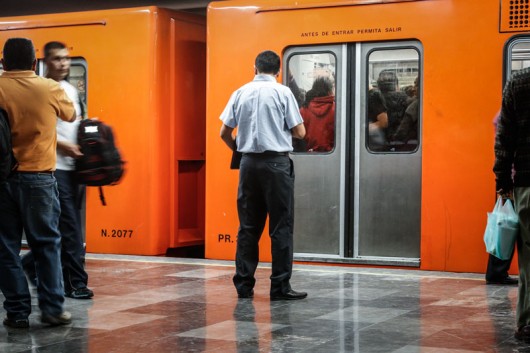
The conflict between neoliberal promotion of gay rights and crackdowns on gay sexual culture has grown in the last five years. Between 2007 and 2012, the Delegation of Cuauhtémoc (a downtown borough) closed the dark rooms of working-class bars, including GoBar, that existed on the edge of the Zona Rosa, a central commercial neighbourhood with numerous LGBTQ-targeted stores and bars. The only remaining gay dark room belongs to an upscale bar in the Condesa neighbourhood, southeast of the Zona Rosa. On March 6, 2014, Mexico City’s only officially gay bathhouse, SO.DO.ME, was closed by the PRD-controlled Delegation of Miguel Hidalgo.
Origins of Pride Week
Police homophobia and violent state repression of the queer community have long been a part of everyday life in Canada. Many don’t know this history of police homophobia, and many have never heard of the Toronto bathhouse riots.
On the cold evening of February 5, 1981, Toronto police raided four gay bathhouses in Toronto’s Church Street district. They charged 253 men with being “found-ins in a common bawdy house,” which forced many men out of the closet and into a dangerous world (ruining careers, damaging families, and increasing suicide risk). All four of the bathhouses were heavily damaged by the police, and one of the clubs never reopened. Men were held outside in the cold – some only draped with towels – and subjected to “Vaseline jokes” and homophobic slurs.
The next night, the queer community fought back. The bastion of liberal opinion the Toronto Star described it as a “rampage” and a “riot.” The anti-police sentiments of the queer community were clear: “No more cops!” they chanted. This clash of the queer community and the police was followed by a series of protests, hunger strikes, and parliamentary manoeuvring. Collectively, these actions and demonstrations morphed into the Toronto Pride Week.
In contemporary Toronto Pride marches, the police have a major presence, but now they are marching in the parade not fighting against it. When progressive allies cheer on the police at events like the Toronto Pride Parade, it camouflages the homophobia and abuse still perpetrated by police services. Ask any queer youth about their fear of reporting queer-bashing at school or the workplace to the police.
To learn more about the queer liberation movement and its relation to the state and its policing complex, see the new book Against Equality: Queer Revolution, Not Mere Inclusion, edited by Ryan Conrad (AK Press, 2014). – Brendan Bruce
In Mexico City, the ability to easily record a sexual encounter on a phone has added a new dimension to a long history of gay blackmail. In a Huffington Post Mexico article about metrear, a young man named Uriel describes how his sexual partner filmed their encounter on a phone camera and afterwards demanded Uriel pay 5,000 pesos to delete the file or his family would be shown the video. When asked why he did not contact security at the metro, he said: “It would only get worse. To them we are a scourge. If the other guy said I was metreando, I would be in the wrong.”
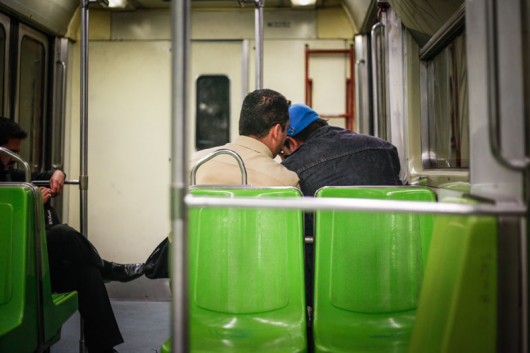
The STC followed the recommendations of the human rights commission and reopened the last three cars on the selected lines in March 2013. Anecdotal evidence suggests that the number of security guards in the last car has noticeably increased, making it impossible to have sexual contact beyond a certain level in the mostly deserted car at night.
Reflecting on the changes in metrear over the last 25 years in which he has been observing and participating, Gomez says that young people today seem to take a more expansive view of metrear than his generation did, but they are not necessarily abandoning the historical spaces associated with it. “Before the middle of the night, they go to the subway to dance, sing, laugh, sometimes drinking – almost like they forgot the initial reason for being there: sex.”
Josh Mentanko is a graduate student in history at York University where he studies modern Mexican cultural history.
